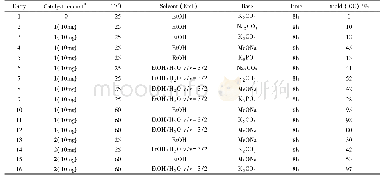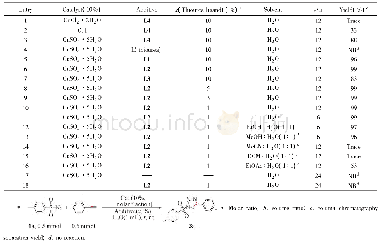《Tab.1 Screening of conditions of Suzuki reaction catalyzed by 1 and 2》
 提示:宽带有限、当前游客访问压缩模式
提示:宽带有限、当前游客访问压缩模式
本系列图表出处文件名:随高清版一同展现
《基于纳米二氧化硅与MCM-41的两种多相钯催化剂的合成及其在Suzuki反应中的应用(英文)》
*Molar percentage of Pd,0.11%mol;GC,Gas chromatograph yield.
After fully characterizing the catalysts,we further investigated their catalytic activities in Suzuki reaction.To optimize the reaction conditions,the Suzuki coupling of bromobenzene(1 mmol)with phenyl boronic acid(1 mmol)was examined using different catalysts and solvents at a temperature range of 25~60℃(Tab.1).In these experiments,only environment-friendly ethanol and water were used as solvents.When the reaction was carried out without catalyst,there was no product(Entry 1).Catalyst 1 was selected as the main condition optimization object.In the first stage,different bases and solvents were used,and the results showed that the yields of the reaction were low at room temperature(Entry 2~9).In the two cases of Entry4(Et OH,Me ONa)and Entry 7(Et OH/H2O v/v=3/2,K2CO3),the yields are slightly higher.In the second stage,the reaction temperature was increased from room temperature to 60℃.The best result wasobtained when EtOH/H2O(v/v=3/2)was employed as solvent and K2CO3was employed as base.In the third stage,catalyst 2 was used in the same optimum conditions as catalyst 1,and it also achieved wonderful results(Entry 16).
| 图表编号 | XD0052530500 严禁用于非法目的 |
|---|---|
| 绘制时间 | 2019.04.18 |
| 作者 | 曹锰、王振希、张健、徐胜、张尚玺、柳阳、戴欣、江新德、吴锦辉 |
| 绘制单位 | 南昌工程学院理学院、南昌工程学院理学院、南昌工程学院理学院、南昌工程学院理学院、南昌工程学院理学院、南昌工程学院理学院、南昌工程学院理学院、南昌工程学院理学院、南昌工程学院理学院 |
| 更多格式 | 高清、无水印(增值服务) |





